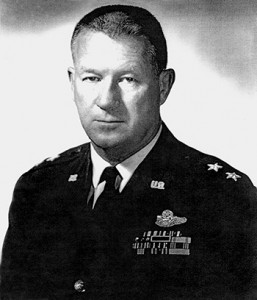NGEF Guard Muster
Donald J. Strait
The one name perhaps most associated with the history of the New Jersey Air National Guard is Major General Don Strait. Donald Jackson Strait was born in East Orange New Jersey on 28 April 1918. He was interested in aviation since his very early years and in 1940, he enlisted in the New Jersey National Guard’s 119th Observation Squadron just about the time that unit was called to active duty. Starting as an armorer, he quickly advanced to become an observer and aerial gunner on the unit’s Douglas O-46 and North American O-47 observation planes. Squadron officers saw the potential in the young Strait and convinced him to apply for the Army’s aviation cadet program, which he entered in March 1942. Less than year later he received his wings and commission as 2nd Lieutenant in the Army Air Force at Maxwell Field, Alabama.
Thanks to his high standing in the graduating cadet class, he received his first choice assignment as a fighter pilot flying the P-47 Thunderbolt. Strait completed P-47 training at Bradley Field, Connecticut, in March 1943 and was assigned to the 361st Fighter Squadron, a unit of the 356th Fighter Group, which was undergoing operational training in preparation for overseas deployment at Westover AB, Massachusetts. On 5 September 1943, the Group, consisting of the 359th, 360th and 361st Fighter Squadrons, embarked on the RMS Queen Elizabeth for their voyage to the United Kingdom and eventual air combat in the European skies.
The Group, now attached to the 8th Air Force’s 65th Fighter Wing, was based at Martlesham Heath (AAF Station 369) in Suffolk, England. On 15 October 1943 Capt Don Strait flew his first mission over northern France. His first aerial combat took place on 6 February 1944 while flying one of a succession of P-47D Thunderbolt’s assigned to him, all named “Jersey Jerk” in recognition of his home state. By the end of his first combat tour, Strait achieved 2 aerial victories (both Me-109s). Returning in September 1944 for his second combat tour, he joined his squadron in the transition to the P-51D Mustang; his personal aircraft was again named “Jersey Jerk.” He was promoted to Operations Commander then Squadron Commander of the 361st. Through the end of the war in Europe, now Maj Strait achieved a further 11 ½ aerial victories (5 ½ Me-109s, 3 FW-190s and 3 Fi-156s) for a total of 13.5 while flying 122 combat missions over his two tours. He was the highest scoring pilot in the Group and one of the two former National Guard pilots to become aces during WWII.
After a short stint at the Office of Flying Safety, Strait temporarily left the service only to rejoin the 119th Fighter Squadron, 108th Fighter Wing, New Jersey Air National Guard at the end of 1947 as Operations Officer. In 1949 while he was Squadron Commander, the 119th won the first Spaatz Trophy awarded for the outstanding National Guard flying unit. In 1950 then Lt Col Strait was promoted to the Executive Officer of the 108th Tactical Fighter Wing that included both the 119th and newly organized 141st Fighter Squadrons. On 1 March 1951 the Wing was called to active duty as a result of the Korean War. The activated wing, now composed of the 141st as well as the 149th (VA ANG) and 153rd (MS ANG) Fighter Squadrons, was put under Strait’s command and transferred to Turner AFB as part of the Strategic Air Command for the bomber escort role. Later, Strait took the Wing to Goodman AFB, as a fighter-bomber unit. At the end of 1952, the 108th was relieved of active duty and returned to state control. On 1 July 1955 the designation was changed to the 108th Fighter Interceptor Wing and Col Strait was named Wing Commander. Also in 1955 Strait became the first Air Guard officer to graduate from the Air War College. While still Wing Commander, he was appointed by President Eisenhower to be Deputy Assistant Secretary of the Air Force for reserve affairs.
During the 1961 Berlin Crisis now Brig Gen Strait was assigned the task of organizing Operation Stair Step, the successful deployment of called-up Air National Guard units to Europe. More than 100,000 ANG personnel and a total of 216 aircraft were safely deployed without a single mishap and without aerial tanking support. During the 1962 Cuban Missile Crisis Strait was assigned to TAC Headquarters to plan the utilization of Guard units for striking Cuba. He was personally responsible for obtaining Mach 2 F-105Bs for the NJANG – the first Guard unit to fly such a high performance aircraft. Major Gen Strait eventually commanded the entire New Jersey Air National Guard.
He also began a second career in 1968 as an executive with Republic Aviation, (then Fairchild-Republic) and was instrumental in the development of the A-10 Thunderbolt II. Major General Strait retired from the Air Force in 1978, and retired from Fairchild – Republic Corp. somewhat later.
Donald Strait has left his imprint on the Air National Guard – from enlisted armorer, aerial observer and gunner; to fighter ace; then squadron commander, wing commander and eventually commander of the NJANG; he organized the first and most significant mass deployment of ANG forces during the Berlin Crisis; he was the first New Jersey ANG officer to be appointed Major General, the first ANG officer to attend the Air War College and most importantly, he was a life-long advocate of the Guard.
His military decorations include the Silver Star; Legion of Merit; Distinguished Flying Cross (2 Oak Leaf Clusters); Air Medal (14 Oak Leaf Clusters); Presidential Unit Citation; Victory Medal; European Theatre Ribbon (4 Battle Stars); American Defense Ribbon; USAF Exceptional Civilian Service Award; and Republic of Vietnam Gallantry Cross with Palm. He was inducted into the NJ Aviation Hall of Fame in 1989. Donald Strait “flew west” on 30 March 2015.


